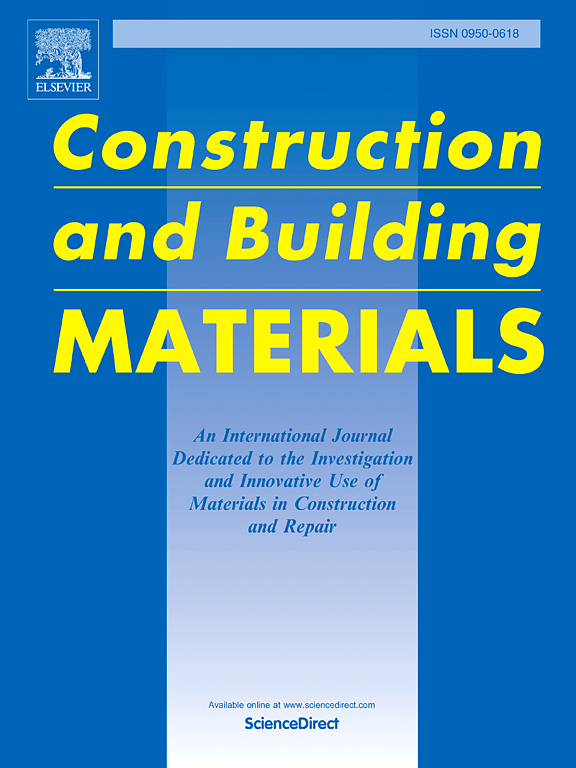Research on blending and diffusion phenomena of virgin and aged asphalt during the laboratory-simulated construction stage
IF 8
1区 工程技术
Q1 CONSTRUCTION & BUILDING TECHNOLOGY
引用次数: 0
Abstract
This research aims to quantify the degree of blending (DoB) between virgin and aged asphalt binders in recycled asphalt mixture during construction stage by using the Confocal Laser Scanning Microscopy (CLSM) technology. In this research, virgin SBS-modified binder was employed as a tracer. Wood cube aggregate was used as RAP aggregate to be distinguished from the asphalt mixtures. Various heating temperature and storage time conditions were set up for laboratory-produced recycled asphalt mixtures to simulate different construction stages, including storage, transportation, laying, and compaction processes. The CLSM was utilized to detect fluorescence concentration diffusion of virgin SBS-modified binder on the simulated RAP aggregate samples at each construction stage. A method for quantifying the DoB of virgin and aged asphalt binders was proposed. Results demonstrated that the simulated construction stages have significant impacts on blending efficiency of virgin and aged asphalt binders. After mixing process, the DoB of tested binders was found to be 43.4 %. The DoB values increased 19.7–31.6 % during storage stage range, and 7.2–9.2 % during transport stage. The DoB values only increased 2–4 % during laying and compaction stage. The overall increase of the DoB can be as high as 30 %, indicating that settings of construction stages are crucial for the blending of virgin and aged asphalt binders in recycled asphalt mixtures.
实验室模拟施工阶段初沥青与老化沥青的掺合与扩散现象研究
本研究旨在利用共聚焦激光扫描显微镜(CLSM)技术,量化再生沥青混合料在施工阶段初拌与老化沥青粘结剂之间的掺合程度。本研究采用原生sbs改性粘合剂作为示踪剂。RAP骨料采用木立方骨料,以区别于沥青混合料。为实验室生产的再生沥青混合料设置了不同的加热温度和储存时间条件,以模拟不同的施工阶段,包括储存、运输、铺设和压实过程。利用CLSM检测模拟RAP骨料样品在每个构建阶段的原始sbs修饰粘合剂的荧光浓度扩散。提出了一种量化初拌和老化沥青粘结剂DoB的方法。结果表明,模拟施工阶段对初拌和老化沥青粘结剂的掺合效率有显著影响。经混合处理后,所测粘合剂的DoB为43.4% %。贮藏阶段的DoB值增加19.7 ~ 31.6 %,运输阶段的DoB值增加7.2 ~ 9.2 %。在铺设和压实阶段,DoB值仅增加2 ~ 4% %。DoB的总体增幅可高达30% %,说明施工阶段的设置对再生沥青混合料中原始沥青和老化沥青粘结剂的混合至关重要。
本文章由计算机程序翻译,如有差异,请以英文原文为准。
求助全文
约1分钟内获得全文
求助全文
来源期刊

Construction and Building Materials
工程技术-材料科学:综合
CiteScore
13.80
自引率
21.60%
发文量
3632
审稿时长
82 days
期刊介绍:
Construction and Building Materials offers an international platform for sharing innovative and original research and development in the realm of construction and building materials, along with their practical applications in new projects and repair practices. The journal publishes a diverse array of pioneering research and application papers, detailing laboratory investigations and, to a limited extent, numerical analyses or reports on full-scale projects. Multi-part papers are discouraged.
Additionally, Construction and Building Materials features comprehensive case studies and insightful review articles that contribute to new insights in the field. Our focus is on papers related to construction materials, excluding those on structural engineering, geotechnics, and unbound highway layers. Covered materials and technologies encompass cement, concrete reinforcement, bricks and mortars, additives, corrosion technology, ceramics, timber, steel, polymers, glass fibers, recycled materials, bamboo, rammed earth, non-conventional building materials, bituminous materials, and applications in railway materials.
 求助内容:
求助内容: 应助结果提醒方式:
应助结果提醒方式:


